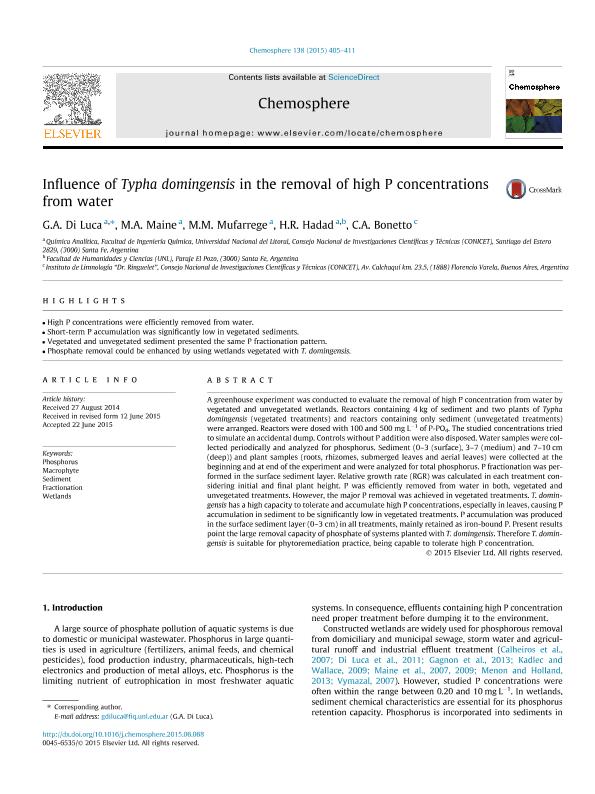Artículo
Influence of Typha domingensis in the removal on high P concentrations from water
Di Luca, Gisela Alfonsina ; Maine, Maria Alejandra
; Maine, Maria Alejandra ; Mufarrege, María de Las Mercedes
; Mufarrege, María de Las Mercedes ; Hadad, Hernán Ricardo
; Hadad, Hernán Ricardo ; Bonetto, Carlos Alberto
; Bonetto, Carlos Alberto
 ; Maine, Maria Alejandra
; Maine, Maria Alejandra ; Mufarrege, María de Las Mercedes
; Mufarrege, María de Las Mercedes ; Hadad, Hernán Ricardo
; Hadad, Hernán Ricardo ; Bonetto, Carlos Alberto
; Bonetto, Carlos Alberto
Fecha de publicación:
11/2015
Editorial:
Elsevier
Revista:
Chemosphere
ISSN:
0045-6535
Idioma:
Inglés
Tipo de recurso:
Artículo publicado
Clasificación temática:
Resumen
A greenhouse experiment was conducted to evaluate the removal of high P concentration from water by vegetated and unvegetated wetlands. Reactors containing 4 Kg of sediment and two plants of Typha domingensis (vegetated treatments) and reactors containing only sediment (unvegetated treatments) were arranged. Reactors were dosed with 100 and 500 mg L-1 of P-PO4. The studied concentrations tried to simulate an accidental dump. Controls without P addition were also disposed. Water samples were collected periodically and analyzed for phosphorus. Sediment (0-3 (surface), 3-7 (medium) and 7-10cm (deep)) and plant samples (roots, rhizomes, submerged leaves and aerial leaves) were collected at the beginning and at end of the experiment and were analyzed for total phosphorus. P fractionation was performed in the surface sediment layer. Relative growth rate (RGR) was calculated in each treatment considering initial and final plant height. P was efficiently removed from water in both, vegetated and unvegetated treatments. However, the major P removal was achieved in vegetated treatments. T. domingensis has a high capacity to tolerate and accumulate high P concentrations, especially in leaves, causing P accumulation in sediment to be significantly low in vegetated treatments. P accumulation was produced in the surface sediment layer (0-3cm) in all treatments, mainly retained as iron-bound P. Present results point the large removal capacity of phosphate of systems planted with T. domingensis. Therefore T. domingensis is suitable for phytoremediation practice, being capable to tolerate high P concentration.
Palabras clave:
Phosphorus
,
Macrophyte
,
Sediment
,
Fractionation
,
Wetlands
Archivos asociados
Licencia
Identificadores
Colecciones
Articulos(ILPLA)
Articulos de INST.DE LIMNOLOGIA "DR. RAUL A. RINGUELET"
Articulos de INST.DE LIMNOLOGIA "DR. RAUL A. RINGUELET"
Citación
Di Luca, Gisela Alfonsina; Maine, Maria Alejandra; Mufarrege, María de Las Mercedes; Hadad, Hernán Ricardo; Bonetto, Carlos Alberto; Influence of Typha domingensis in the removal on high P concentrations from water; Elsevier; Chemosphere; 138; 11-2015; 405-411
Compartir
Altmétricas



